Jadual Kandungan
1900-1940-an: Perkembangan Getah
1905-1909: Permulaan Ladang Getah
Sementara itu, sekitar tahun 1905-1906, getah mula ditanam di Pahang, termasuk di sekitar Kuantan.
“The pioneering of rubber cultivation in Pahang was a slow and hesitant business compared with the rapid expansion which took place in the western States during the early years of this century. In Pahang the first experimental plantings were made by the manager of the Pahang Corporation in 1897 and 1898 but it was not until 1905 that any planting was done on a commercial scale.
…
(W.H.) Derrick (one of the early managers of the Pahang Corporation) planted the first rubber in Pahang on lot 1144 (Mukim Kuala Kuantan) on the banks of the Kuantan River near Kuala Riau in 1897. The following year he opened another small plot at Tanjong Putus, also on the banks of the Kuantan River, and a larger area at Talam in the vicinity of one of the tapioca estates. Kuantan 408/98, Kuantan 514/98, Kuantan 116/00, and Kuantan 282/04.
…
In the Kuantan District, where the first experimental plots had long been established, the lack of roads acted as a deterrent to outside capital. The successful development of commercial cultivation thus depended on local capital
and local initiative. In 1905 and 1906 three moves were made to open up rubber estates but none came to immediate fruition. Tan Ah Choon, owner of the Semambu Tapioca Estate, applied to replant it with rubber, revealing that the “sandy and useless land” he had been granted was in reality a hill of rich volcanic soil. His request was approved but a rise in the price of tapioca intervened and he postponed the planting of rubber for several more years. A
European syndicate, formed by the contractor building the road to Gambang, applied for 2,000 acres adjacent to the tapioca estate but since road construction did not progress as anticipated they lacked the financial resources to open up their estate. The Pahang Corporation obtained an additional 400 acres at Talam but development of that was delayed while the company was reorganised. In the meantime the first rubber smallholdings in the Kuantan District
were planted by Sumatran Malays in the vicinity of the tapioca estates and near Gambang.
During 1907 and 1908 there was little rubber planted at Kuantan except by the Pahang Consolidated Company (as the Corporation was now known) and Malay smallholders. However, world prices rose steadily and more and more applications for rubber land were received by the District Office. In 1909 the Pahang Consolidated Company completed planting their 500 acres at Talam and were engaged in protracted negotiations for more land. About the same time two Singapore Chinese began to open up a thousand acre block at Jeram and other outside investors began to bargain for land already developed. The two tapioca estates, together with a number of Malay smallholdings
already planted with rubber, were purchased by two outside groups - one a company registered in Hong Kong and the other a Shanghai syndicate - and organised into rubber estates. (Kuantan 901 /09, Kuantan 110/ 10 and Kuantan 229/ 10. These are part of the present day Semambu, Ruby, and Atbara Estates.) It was clear to all that the Kuantan District stood on the threshold of a new period of development.
…
Much of this correspondence is contained in Kuantan 982/09. The Kuantan District Officer supported their application on the grounds that they had fully planted their existing land at Talam in a “cheap and systematic way” and had assembled their processing equipment ready to begin tapping the first 25 acres of mature rubber as soon as their labourers arrived from Java. The British Resident for Pahang opposed the application on the grounds that they had done little to develop their mining concession and should not be given any additional land until they did so.
The high prices paid for land already planted with rubber acted as a stimulus for a further expansion of smallholder cultivation, especially by Malays. Although Chinese traders and contractors shared in the opening up of
land in the vicinity of Kuantan town there was no similar development at Gambang. Most Chinese there were still fully occupied with mining and even when applications were made for rubber land the government refused to
alienate it on the grounds that it might later be required for mining.
…
The development of commercial agriculture took place within the enclaves of economic development created by mining activities. After a decade marked only by some small scale experiments, several tapioca and coconut estates were established near the East Coast points of entry at the turn of the century. At a time when rubber cultivation was becoming increasingly important in the western States its introduction into Pahang came slowly. In the Raub and Bentong districts, closely linked to Selangor by the Pahang Trunk Road, the first rubber estates were opened up by outside companies from 1905 onwards. At Kuantan the initiative was taken by enterprises already established there, but development was slow until local investment was supplemented by outside capital in 1909. In both areas immigrant Malays quickly responded to the new opportunities and planted smallholdings with rubber. Soon they were followed by local Malays and other immigrant entrepreneurs. Later, as the alluvial tin deposits of Tras and Bentong showed evidence of exhaustion, there was a transfer of Chinese capital and labour from mining to this new form of agriculture.
…
In 1909 the foundations for the future expansion of rubber cultivation were well established. The first experimental plots had reached maturity, a number of estates had been cleared and planted, and there was a rapidly increasing demand for rubber land in all of the accessible areas. During that year the government made decisions to proceed with the long-discussed East Coast Railway and to extend the Pahang Trunk Road through the centre of the State to Kuantan. While the limitations of Pahang's mineral wealth were widely recognised, her future as an agricultural State now seemed assured. Pahang in 1909 had arrived at the threshold of the rubber era.”
(Sumber: Dr. R.G. Cant, 1973: |"An Historical Geography of Pahang" (PDF), m.s. 63-67).
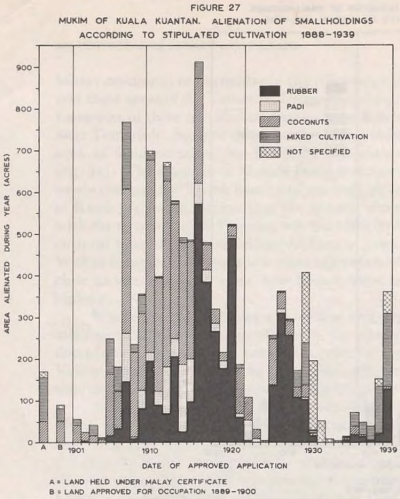
“Mukim of Kuala Kuantan. Alienation of smallholdings according to stipulated cultivation 1888-1939” (Dr. R.G. Cant, 1973: |"An Historical Geography of Pahang" (PDF), m.s. 58-59).
“Although Kuala Kuantan was well removed from both mining areas it was the only point of entry to the region and the sole commercial centre of any importance. The majority of its two thousand inhabitants lived in two streets of brick shop houses which paralleled the river frontage. Chinese made up 65 per cent of the population but there were more Malays in Kuantan than in any other urban centre in Pahang. Roads leading out of Kuantan were few and poorly formed but commercial agriculture was already established in its hinterland (fig. I ).
Two European coconut estates, located on opposite sides of the river near the town, showed little evidence of prosperity or even activity; the soil had proved to be infertile and the crops were unsatisfactory. Further away from the town, on the better soil and slightly higher land around the foot of Bukit Galing and Bukit Beserah, were several rubber estates. At Talam the Pahang Consolidated Company's five hundred acre estate was fully planted and the processing plant was ready for tapping to begin on twenty-five acres of rubber which had reached maturity. Adjacent to this estate a number of Malay rubber holdings had been purchased and combined into the Ruby Estate and
some of the trees here were also nearing maturity. Nearby, at Sungei Talang, and further north at Semambu, the two former tapioca estates were being planted with rubber while the Chinese estate at Jeram was being cleared in
prepartion for interplanting with rubber and tapioca.
In the vicinity of these estates and round the margins of the town were many occupied smallholdings. These were owned by settlers of all races and contained a variety of vegetables and trees, both subsistence and commercial.
Many older ones were planted with coconuts while numbers of the more recently occupied were planted with rubber after the pattern already observed in the Western Mining Periphery.
Elsewhere in the region there was very little agriculture. At several points on the Kuantan River and along the coast, more especially to the north of Kuan tan, there were Malay kampongs with land alienated either for kampong
cultivation or for coconuts. In each case, however, the area taken up for agriculture was inadequate for the needs of the settlers. At Beserah, Tanjong Lumpur, and other coastal settlements, the people relied mainly on fishing,
while those from the riverine kampongs depended on boatwork and other forms of casual employment to supplement their subsistence income. The amount of land alienated for padi was negligible (fig. 27). The return for land under
cultivation on .Jan. 1st, 1910, includes 300 acres of dry padi and 600 acres of wet padi but almost all of this was grown in ladangs. (The cultivation returned as wet padi was mainly those forms of cultivation known as paya chedong and paya tabor. Swamps were cleared and burnt during the dry season and two or three consecutive crops were taken off before the land was allowed to revert to belukar. Since 1909 was an unusually dry year the area cleared was larger than usual. For a description of padi planting methods in Kuantan see Kuantan 650/99.)”
(Sumber: Dr. R.G. Cant, 1973: |"An Historical Geography of Pahang" (PDF), m.s. 78-79).
LATAR LOKASI: Beserah
1901-1911: Kedatangan Melayu Perantau
Menurut banci tahun 1901 di Kuantan, dalam setiap 1,000 orang Melayu, 437 orang (hampir separuh) daripadanya adalah Melayu Perantau yang berasal dari luar negeri Pahang:-
“The 1901 census records the number of foreign Malays (i.e. Malays born outside of Pahang) per thousand of Malay population in each District:-
Lipis 45
Pekan 105
Temerloh 13
Raub 245
Kuantan 437
The 1911 census does not give comparable figures on a district basis but other evidence contained therein suggests that the pattern persisted.
…
In the Kuantan District the most important change was the arrival of 179 indentured Javanese to work on the Pahang Consolidated Company rubber estates in 1910.
…
Since the Kuantan District had attracted immigrants at a faster rate than any other area of Pahang in the period before 1909, it is almost certain that well over half the population of the region was Chinese and that most of the
Malays came from areas outside of Pahang. (The percentage population increases for the Kuantan District during the intercensal periods 1891-1901 and 1901-1911 were as follows: Malay population 62.5 and 61.5 percent; Chinese population 85. 7 and 326 percent; total population 60. 7 and 153 percent. See also figure 30.). The main concentrations of Chinese population were in the mining areas of Gambang and Ulu Kuantan and in the town of Kuala Kuantan. In addition they were to be found as labourers on the estates, storekeepers and traders in the Malay coastal villages, and smallholders in the vicinity of the estates and the town. The main nucleations of Malay population were to be found on the fringes of Kuantan town, at various points along the Kuantan River as far inland as Sungei Lembing, and at the mouths of the various small rivers along the coast. A considerable proportion of those who fished off the Pahang coast during the period from March to October each year still returned to their homes in Kelantan and Trengganu during the north-east monsoon season but the number of permanent settlers in the coastal area was considerably greater than it was two decades before. The population of the North-eastern Mining Periphery had been transformed to a much greater extent than that of any other area of Pahang.”
(Sumber: Dr. R.G. Cant, 1973: |"An Historical Geography of Pahang" (PDF), m.s. 69, 71, 79).
1909: Keadaan Daerah Kuantan
Pada tahun 1909, negeri Pahang dibahagikan kepada 5 daerah: Lipis, Temerloh, Pekan, Raub, dan Kuantan. Kuantan terpisah daripada daerah-daerah yang lain: hanya dapat dicapai melalui jalan laut sahaja, dan banyak berurusan dagang secara langsung dengan Singapura. Oleh itu ia agak terpinggir oleh pentadbiran British yang berpusat di Kuala Lumpur dan Kuala Lipis:-
“In 1909 Pahang was divided into five administrative Districts which, with some slight modification, are a useful basis for a threefold regional division (fig I.) The largest of the three consists of the Lipis, Temerloh, and Pekan Districts and is termed the Central Region. These three Districts were tied together by the Pahang waterway and they contained the bulk of the indigenous Malay population. The second region is the Western Mining Periphery and comprises most, but not all, of the Raub District. Originally it had been part of the Ulu Pahang District but, with the growth of mining in the vicinity of Raub, Tras, and Bentong, it was separated from the Lipis area and given its own administrative centre at Raub. Since the Raub mukims of Sega, Dong, and Ulu Dong were little influenced by the adjacent mining development, and since their population was almost exclusively Malay, they are included in the Central Region. The remaining region is the Kuantan District which formed the North-eastern Mining Periphery. It was linked to the rest of Pahang only by sea communications and it thus formed a self-contained economic unit. Included with it is a small portion of the Pekan District adjacent to the Gambang mining area.”
Walaupun kadar penghasilan bijih timah per capita di Kuantan adalah yang tertinggi ketika itu, rangkaian jalan-jalan di daerah tersebut adalah paling sedikit berbanding daerah-daerah lain, apatah lagi negeri-negeri lain di pantai barat:-
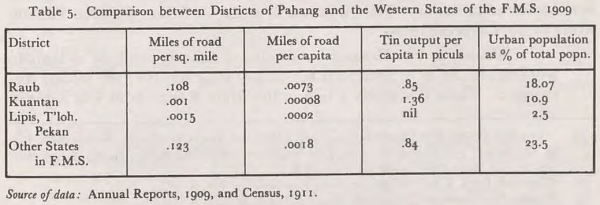
“Table 5. Comparison between Districts of Pahang and the Western States of the F.M.S. 1909 - Source of data: Annual Reports, 1909, and Census, 1911. … In 1911 the population of Bentong was 2,050 and Kuantan 2,102.”
“In 1909 the coastal District of Kuantan had no land links with the rest of Pahang. Whereas the Raub District was closely tied to the economy of the western States, Kuantan's regular trade links were with the British Colony of Singapore at the southern tip of the Peninsula. Political control was, however, effected through Kuala Lumpur and Kuala Lipis and the views of the Kuantan District Officers carried little weight in the formulation of policy and the apportionment of expenditure. (Recommendations by the Kuantan District Officers were often curtly over-ruled by the British Resident, Pahang. Many of the Kuantan office files and even the Kuantan Annual Report for 1909 contain pathetic pleas for more expenditure, particularly on roads. The junior status of the civil servants appointed to Kuantan, and the unimportance of this District in the eyes of the Malay rulers, made it easy for the B.R. to decline such requests at times when he was endeavouring to keep State expenditure to a minimum.) Kuantan stood in political and economic isolation from the rest of the State and it is not surprising that expenditure had been limited to the provision of administrative buildings and the dredging of the Kuantan harbour.
The indices in Table 5 highlight the differences between the two mining regions of Pahang. In spite of a lack of internal roads, and the high cost of river transport to Gambang (The 20 mile road from Kuantan to Gambang had been started in 1905 but was still uncompleted in 1909.), the minerals produced in the Kuantan District
were of greater value than those produced by Raub; alluvial tin production from the Gambang field was only slightly less than that from the Raub District and the value of the tin produced by the Pahang Consolidated Company was
greater than that of the gold produced by the Raub Australian Gold Mines.
…
In 1909 those forces which had earlier transformed the West Coast of the Peninsula had made an indelible impact on the geography of Pahang. The effects of tin mining, the influx of Chinese immigrants, and the growth of new roads and new towns had produced a pattern of change in the western periphery of Pahang that was almost identical to that which had taken place in Selangor in earlier decades. Any regional geographer writing in the year 1909 could well have included the Raub-Bentong area as an eastern extension of the West Coast Tin and Rubber Region. In the Kuantan District on the East Coast the changes were even greater but because of its isolation, its lack of roads, and its orientation away from the centres of political control, Kuantan in 1909 was a region without counterpart elsewhere in Malaya.”
(Sumber: Dr. R.G. Cant, 1973: |"An Historical Geography of Pahang" (PDF), m.s. 71, 73, 75-77, 80).
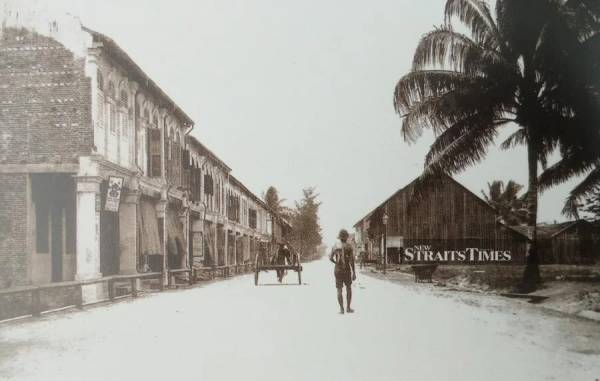
Kuantan, awal kurun ke-20: “A street in Kuantan during the first decade of the 20th century.” (Alan Teh Leam Seng @ New Straits Times, May 5, 2019: |"Tracing Pahang's three capitals").

Padang Awam Kuantan, 1913 (关丹 Kuantan @ Facebook, 6 Mei 2019: "關丹舊照片").
Sistem Pendidikan Awal
“Perkembangan sistem pendidikan di Kuantan pada peringkat awal (zaman sebelum perang) tidaklah semaju di daerah Bentong dan Kuala Lipis. Hal ini demikian kerana kesulitan sistem perhubungan telah mempengaruhi kemudahan pendidikan, di samping pembangunan ekonomi yang kurang, taburan penduduk tidak sekata dan komposisi etnik. Pada akhir kurun ke-19 dan awal kurun ke-20 wujud syarikat-syarikat Eropah yang mengusahakan ladang getah, perlombongan dan sebagainya. Oleh itu, orang-orang Cina telah menduduki kawasan bijih timah di Sungai Lembing dan Gambang. Di sinilah antara sekolah yang terawal dibina terutama sekolah Cina. Sekolah Melayu yang awal pula dibina di bandar Kuantan iaitu kira-kira penghujung tahun 1890-an. Tarikh yang diketahui berkenaan sekolah ini ialah 1904 / 1905 apabila sekolah tersebut dipindahkan ke tapak asalnya di sudut tapak pasar lama yang berhampiran dengan Jalan Lebai Ali ke tapak barunya di Padang Lalang. Ketika itu sekolah ini bernama Sekolah Melayu Padang Lalang. Selepas 1903 hinggalah pendudukan Jepun, 8 buah lagi sekolah didirikan. Dalam tahun 1930 murid-murid lelaki di Sekolah Padang Lalang dipindahkan ke Sekolah Melayu Laki-laki Teruntum, Jalan Gambut dan Sekolah Padang Lalang menjadi sekolah Melayu Perempuan (Tahun 1948 sekolah ini mendapat bangunan barunya di Sekolah Perempuan Galing).” (roshanilawatey, 30 Jun 2010: |"Sejarah Kuantan (5) : Kemudahan Pendidikan"). (Kemungkinan antara sumber asal: Alias Abdullah, Jabatan Perancang MPK dan Fauziah binti Zakaria, |"Pahang Dalam Sejarah, Bil.4, Tahun 1989", m.s.1: Sejarah Pembukaan Kuantan (1850-1970)).
1909-1915: Kemuncak Lombong Sungai Lembing
Hasil bijih timah di Gambang mulai menurun secara beransur-ansur sejak tahun 1909 lagi, oleh kerana beberapa faktor, antaranya mutu bijihnya agak rendah, serta teknologi perlombongan dan pengangkutan yang kurang dimajukan, berbanding lombong-lombong lod di Sungai Lembing. Lombong-lombong bijih timah di Raub dan Tras juga mengalami kemerosotan. Kemuncaknya ialah pada tahun 1914-1915, apabila pekerja lombong di Gambang mula berpindah ke Sungai Lembing dan daerah-daerah lain, atau ke ladang-ladang getah yang sedang berkembang pesat ketika ini. Loke Yew sendiri merancang untuk mengusahakan 10,000 ekar ladang getah di Gambang, malangnya beliau meninggal dunia pada tahun 1917:-
“Alluvial tin mining at Gambang was concentrated into a much smaller area than that on the eastern slopes of the Main Range (fig. I). This field employed fewer miners in 1909 but the actual output of tin was almost as great. (At Gambang 4,294 miners produced 15,902 piculs of tin according to Mints, (Coast District) A.R. 1909. In the Raub region, 6,251 miners produced 16,988 piculs. P.A.R. 1909.). Lombong mining on the flats was still more important than lampanning in the hills and the three lombong mines owned by Loke Yew together employed over 1,700 workers. Three European companies owned properties but only one was directly engaged in mining. (Bruang Limited were attempting to introduce hydraulicing with monitors. Most of their land, together with that owned by the Belat Tin Mining Company and the Kuantan Tin Mining Company, was worked by tributors or contract gangs. The monthly reports of these three companies were published in the Malay Mail during 1909.). Loke Yew's employees refined 6,000 piculs of block tin in smelters at Belat village while the European companies and other Chinese miners exported a total of 12,630 piculs of tin ore between them. The December census of mining showed that the labour force employed on this field was almost exclusively Chinese and that very little mechanical power was used 23 . Mining at Gambang was still in the labour intensive stage.
Although Gambang was well established as a mining area, other facilities were poorly developed. With the road still uncompleted, supplies for the mines were still being taken up the small Belat River from Kuantan or, in the case
of some mines further west, up the Lepar River from Pekan. Loke Yew ran a steam launch service on the Belat and a number of Sumatran Malays and their employees worked smaller boats which they poled up and down the two rivers. Five years previously the government had proposed to lay out a new town at Gambang but in 1909 no action had been taken and the District Officer at Kuantan lamented that “the Chinese naturally assume that the idea is abandoned and they continue to build at Blat, a site that is objectionable in many ways. (Kuantan A.R. 1909. The old village of Blat or Belat was located on the Belat River at the point where the track from Godown Rasa crossed it. Kuantan 216/05.)”.
While the tin mining operations at Gambang were on a modest scale compared with those of Selangor and Perak, the lode mines at Sungei Lembing were without equal in the Malay Peninsula. All of the mines on the Ulu Kuantan Concession were combined under a single company which employed over 1,600 Asian workers and a European staff of twenty. In contrast to the labour intensive methods used in alluvial mining, these were fully equipped underground mines with mechanical hoisting equipment, stamps and mill all driven by diesel engines and steam boilers. In 1909 the reorganisation of the company was well advanced and work was concentrated on Bell's and Willink's Lodes. During the year they milled over 67 thousand tons of stone and exported 14,964 piculs of tin with an approximate value of $700,000.
The Company's light railway was complete as far as Kuala Reman on the Kuantan River and from there the journey to Kuala Kuantan was completed in a sternwheel steamboat. Further improvements were still needed but access to Sungei Lembing was at this stage better than access to Gambang. The population living in the vicinity of the mines at Sungei Lembing was at least 2,500 and represented one of the largest concentrations in the State. Most were Chinese but there were, in addition, many Javanese and Malays and some Indians. The village of Sungei Lembing itself was described as “a straggling collection of atap huts” but it may well have housed as many people as any town in the State.
Although Kuala Kuantan was well removed from both mining areas it was the only point of entry to the region and the sole commercial centre of any importance. The majority of its two thousand inhabitants lived in two streets of brick shop houses which paralleled the river frontage. Chinese made up 65 percent of the population but there were more Malays in Kuantan than in any other urban centre in Pahang. Roads leading out of Kuantan were few and poorly formed but commercial agriculture was already established in its hinterland (fig. I ).”
(Sumber: Dr. R.G. Cant, 1973: |"An Historical Geography of Pahang" (PDF), m.s. 76-78).
“The greatest increase in mineral production came from the tin mines of the Pahang Consolidated Company at Ulu Kuantan (fig. 21). The Company improved communications between Sungei Lembing and Kuala Kuantan and continued to introduce new equipment except for a period during and after World War I when machinery was not available. In addition, it steadily increased the labour force until in the latter years of the period it employed over three thousand in mining and at least a thousand others in ancillary occupations. The Company diverted much of its money, both working capital and profits from mining, into rubber cultivation, and much of the income earned by its staff, both European and Asian, was also invested in the agricultural development of the Kuantan district. Moreover, it made rail and steamboat facilities available to other settlers along the Kuantan River and made very substantial contributions to State revenue.
At Gambang, the anticipated decline in production of tin set in from 1914 onwards and in the latter years of the period the number of mining labourers at work ranged between five hundred and one thousand. The main exodus took place in 1915 when some labourers moved on to a new tinfield at Mersing in East Johore and others returned to China. Many, however, remained in the Kuantan district and went either to the mines at Sungei Lembing, the town at
Kuala Kuantan, or to new areas being opened up for rubber cultivation. Several mine owners from Gambang invested money in rubber estates both before and during the period of decline. In 1917 a major opportunity was lost when the death of Towkay Loke Yew occurred soon after he had filed an application for 10,000 acres of rubber land at Gambang.
In the vicinity of Raub and Tras the output of alluvial tin continued to decline in spite of an extension of mining northwards into Mukim Batu Talam. From 1914 onwards the most regular producer was a European company using hydraulic methods. At the end of the period annual production from all mines in this area was less than four thousand piculs or Io per cent of that produced by the Pahang Consolidated Company at Kuantan. The number employed in mining fell off even more steeply but the Chinese population of the subdistrict increased between 1911 and 1921 thus suggesting that many of the former mining labourers sought local employment in the towns and agricultural areas.”.
(Sumber: Dr. R.G. Cant, 1973: |"An Historical Geography of Pahang" (PDF), m.s. 78, 82-83, 92).
1909-1921: Perkembangan Getah
“Between 1909 and 1921 there was, in fact, a moderate expansion of rubber cultivation in Pahang. Extensive areas of tropical rainforest were felled and burned, to be replaced by the perennial tree crop; natural plant communities with a multitude of species gave way to a new man-controlled community where a single species was dominant but where the all-important nutrient cycle could be preserved 1 . The acreage planted with rubber increased more than twenty fold and by the end of the period stood at 87,000 acres 2 . During the same time the area of land approved for agricultural occupation trebled from 81,000 acres to over 240,000 acres.
…
An increase of alienation in the central district of Pahang might have been expected in the years which followed but in 1911 the price of rubber fell and the anticipated net return dropped sufficiently to deter new investors. For the next three years most new applications were made by existing estates, and the main expansion thus continued to be in the peripheral regions. The largest single extension was in the Kuantan District where the Pahang Consolidated Company opened up a five thousand acre estate at Kuala Reman, just inside their mining concession. (The P.C.C.L. also obtained a 770 acre extension to their Sungei Talam Estate. Kuantan 89/12.).
…
The years 1910 to 1921 thus represent the period when rubber cultivation extended into Pahang and the majority of the present day estates were established. During this time, however, there were few years when the rate of expansion was not impeded by economic conditions or legal and administrative restrictions. When the era of rubber expansion came to a close in Malaya the agricultural development of Pahang still lagged far behind that of the western States.”
(Sumber: Dr. R.G. Cant, 1973: |"An Historical Geography of Pahang" (PDF), m.s. 81, 89-90, 92).
1920: Pembukaan Sekolah Inggeris
“Di bawah kerajaan Inggeris hanya sebuah sekolah Inggeris dibina dalam tahun 1920. Muridnya hanya 10 orang dengan menggunakan Gudang Padi Kerajaan di Jalan Wall. Hanya dalam tahun 1924 dipindahkan ke Jalan Wong Ah Jang dan dinamakan Sekolah Sultan Abdullah.” (roshanilawatey, 30 Jun 2010: |"Sejarah Kuantan (5) : Kemudahan Pendidikan"). (Kemungkinan antara sumber asal: Alias Abdullah, Jabatan Perancang MPK dan Fauziah binti Zakaria, |"Pahang Dalam Sejarah, Bil.4, Tahun 1989", m.s.1: Sejarah Pembukaan Kuantan (1850-1970)).
1921-1939: Getah Sebagai Kegiatan Utama
Pada tahun 1921, suatu tinjauan mendapati kawasan perlombongan di Gambang tidak lagi sesuai untuk dikerjakan. Sementara itu, tanaman getah secara kecil-kecilan mula dijalankan. : “The Assistant-Warden of Mines visited Gambang to investigate the possibility of a government scheme but his report held out little hope for this once flourishing tinfield :- “The Gambang area consists of a number of small Chinese mines employing five hundred to six hundred coolies. There are no mines of sufficient size to warrant dumping areas on a large scale. There are no instances where land has been fertilized and reclaimed in this decadent and isolated village which I understand was once a prosperous mining town. The majority of the residue tailings pass into a large swamp which would require very considerable expenditure before it could be reclaimed and rendered suitable for anything.” … Tras, Tranum, and Gambang had lost population with the decline in alluvial mining but were finding a new role as centres for areas of smallholding and medium holding rubber cultivation.” (Dr. R.G. Cant, 1973: |"An Historical Geography of Pahang" (PDF), m.s. 101-102).
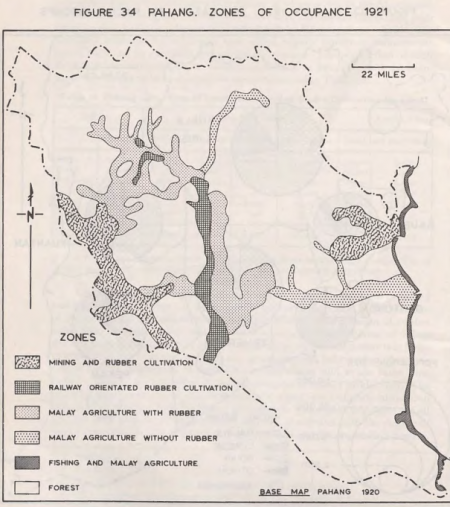
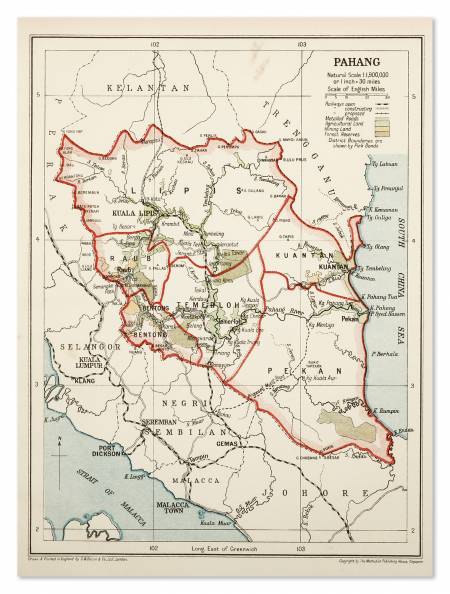
Peta negeri Pahang: Kiri: 1921, Kanan: 1923. Masih ada kawasan perlombongan di hulu Sungai Belat (termasuk kawasan Gambang), tetapi bercampur dengan ladang getah. (Gambar kiri: Dr. R.G. Cant, 1973: |"An Historical Geography of Pahang" (PDF), m.s. 101-102; Gambar kanan: George Washington Bacon (1831? - 1922), 1923: |"Rare map showing state boundaries of Pahang, Malaysia").
Menjelang tahun 1939, perlombongan terus merosot teruk, dan aktiviti ekonomi beralih hampir sepenuhnya kepada getah, namun tidak serancak era perlombongan dahulu: “But whereas in 1888 Raub, Tras, Bentong, Gambang, and Sungei Lembing were, at best, small outposts of temporary settlement, in 1939 they were the foci of important lines of communication and the centres of commercial agriculture and population. At Tras and Gambang mining had again declined almost to insignificance but the roads, the rubber holdings, and many of the people remained.” (Dr. R.G. Cant, 1973: |"An Historical Geography of Pahang" (PDF), m.s. 131).
1926-12: Banjir Besar
“Peak rainfall normally occurs in Pahang during the period December 15th to January 15th and floods at this time are a regular occurrence. At the end of 1926 the monsoonal rain was unusually heavy and resulted in floods of unprecedented severity. The Pahang Annual Report for 1926 records that the fall commenced on December 17th and light to moderate rain continued until the 23rd, 24th, and 25th, when the rain became considerably heavier. The next four days, “the 26th to the 29th,” wrote the British Resident, “will probably figure as the wettest four days of which there are any record. Heavy rain occurred all over the Peninsula, the 27th having the heaviest falls. At Kuantan 20 inches were recorded on that day and 54 inches on the four days 26th to 29th. Moderate rain was general on the 30th and light rain on the 31st”. The rain was heaviest in north Pahang; Kuantan on the coast received 70 to 75 inches during the period December 17th to 31st; … At the mining village of Sungei Lembing damage by silt as well as water was very severe; 270 buildings were destroyed and many of the two-storied shop houses which survived were filled with silt to a depth of twelve to fifteen feet. Two of the mines were flooded and operations were suspended for three or four months while the whole of the labour force was employed in restoring the damage and re-opening communications with Kuantan.” (Dr. R.G. Cant, 1973: |"An Historical Geography of Pahang" (PDF), m.s. 115-116).
“Banjir besar yang dikenali oleh orang-orang Pahang sebagai Bah Keruh melanda Pahang pada 1926 menyebabkan seluruh bandar Kuala Lipis tenggelam.” (Yaakub Isa / Abdullah Affan @ kuantanloka, August 19, 2020: |"Bila Dan Kenapa Kuantan Dipilih Sebagai Ibu Negeri Pahang").
Peta Kuantan 1928
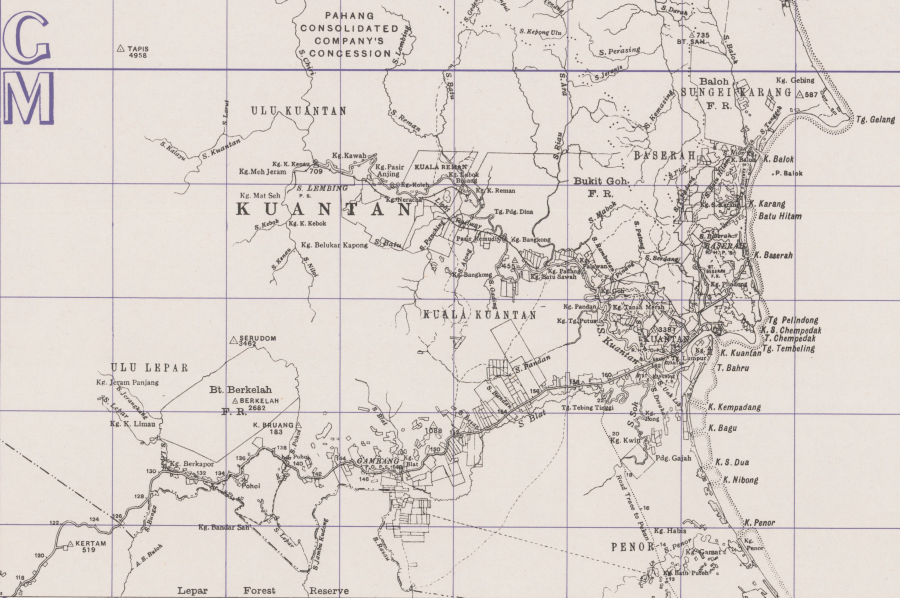
Peta Kuantan tahun 1928 (salinan tahun 1942-1943): “Copied from a map published by the F. M. S. & S. S. Survey dept. 1928.” (Great Britain. War Office. General Staff. Geographical Section, 1942-1943: |"Pahang, 1928").
Awal 1940-an: Penubuhan Lembaga Bandaran Kuantan
“Awal tahun 1940-an, Lembaga Bandaran Kuantan diwujudkan bagi menggantikan “Kuantan Sanitary Board”” (roshanilawatey, 29 Jun 2010: |"Sejarah Kuantan (3) : Pemodenan dan Perubahan Dasar Pentadbiran"). (Kemungkinan antara sumber asal: Alias Abdullah, Jabatan Perancang MPK dan Fauziah binti Zakaria, |"Pahang Dalam Sejarah, Bil.4, Tahun 1989", m.s.1: Sejarah Pembukaan Kuantan (1850-1970)).
